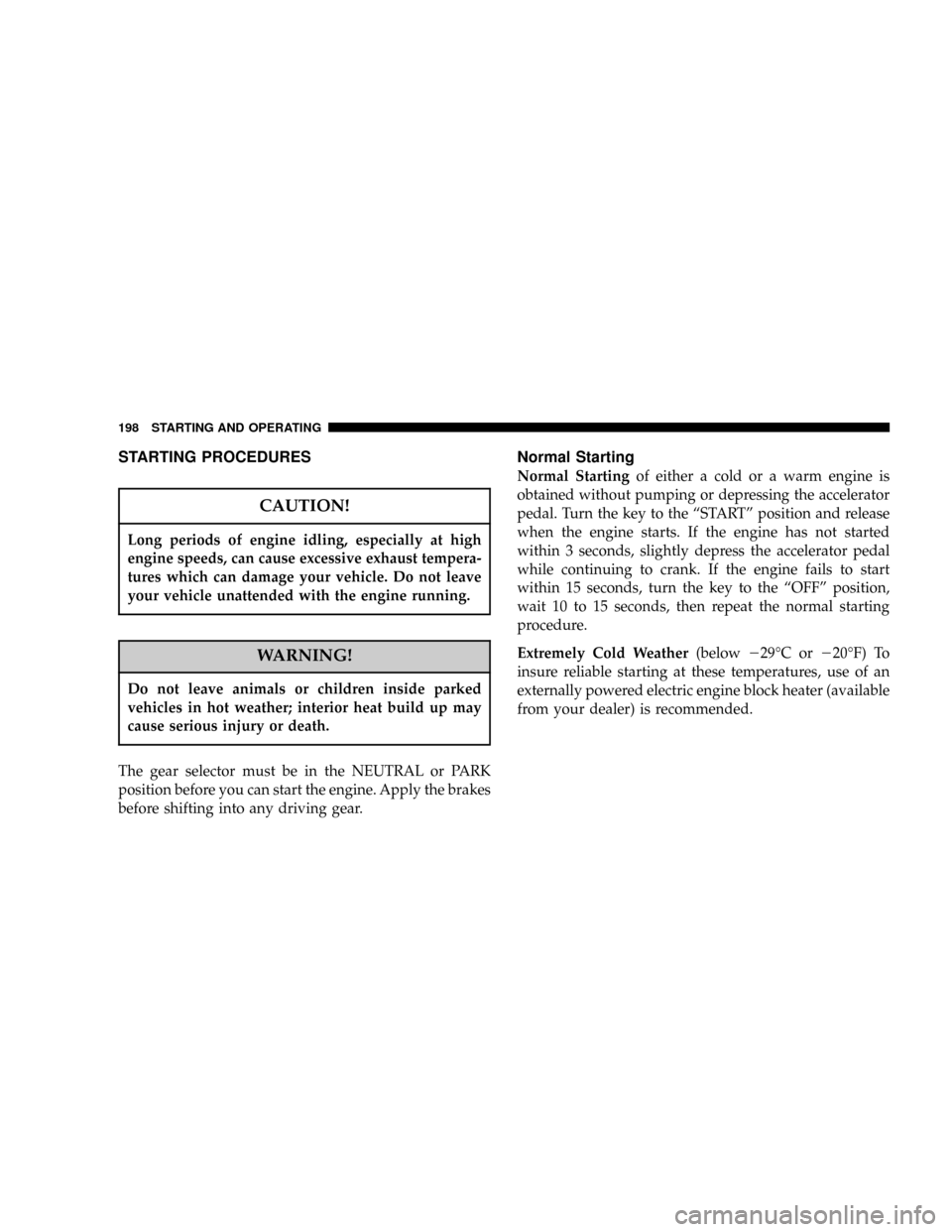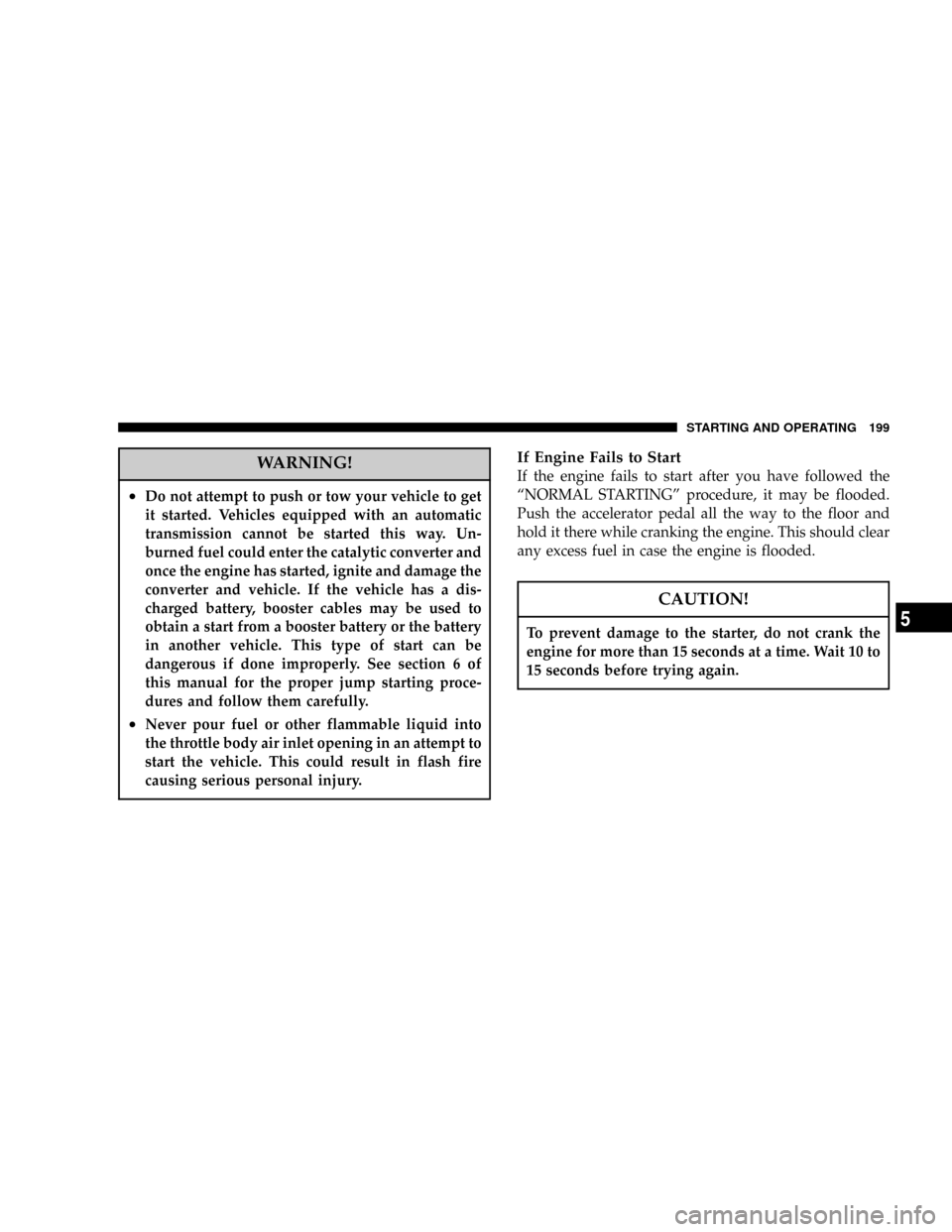CHRYSLER PACIFICA 2004 1.G Owners Manual
Manufacturer: CHRYSLER, Model Year: 2004, Model line: PACIFICA, Model: CHRYSLER PACIFICA 2004 1.GPages: 361, PDF Size: 5.21 MB
Page 191 of 361

Rear Fan Operation
To operate the rear fan, press the9REAR9button. The first
time this button is pressed the9REAR AUTO9display
will illuminate indicating that the rear fan speed is
automatically controlled. To manually control the rear
fan speed, press the9REAR9button again and only
9REAR9will illuminate in the display. This allows the rear
seat occupants to control the rear fan speed using the
switch located in the center console between the second
row seats. By pressing the9REAR9button a third time,
the rear fan will shut off.
When the ATC display reads9REAR AUTO9or when the
rear fan is off, the switch located in the center console
between the second row seats is not functional. When the
ATC display reads9REAR9, only the rear seat occupants
can control the rear fan speed from the rear switch. When
in the ªREARº mode, the rear occupants can set the rearswitch to any fan speed including9OFF9,or9AUTO9.
While in the9AUTO9position, the rear fan speed will be
automatically controlled.
Summer Operation
The engine cooling system in air conditioned vehicles
must be protected with a high-quality antifreeze coolant
to provide proper corrosion protection and to protect
against engine overheating. A 50% solution of ethylene
glycol antifreeze coolant in water is recommended. Refer
to section 7, Maintenance Procedures, of this manual for
proper coolant selection.
Winter Operation
To insure the best possible heater and defroster perfor-
mance, make sure the engine cooling system is function-
ing properly and the proper amount, type, and concen-
tration of coolant is used. Refer to section 7, Maintenance
Procedures, of this manual for proper coolant selection.
UNDERSTANDING YOUR INSTRUMENT PANEL 191
4
Page 192 of 361

Use of the air Recirculation mode during winter months
is not recommended because it may cause window
fogging.
Vacation Storage
Anytime you store your vehicle, or keep it out of service
(i.e. vacation) for two weeks or more, run the air condi-
tioning system at idle for about five minutes in the fresh
air and high blower setting. This will insure adequate
system lubrication to minimize the possibility of com-
pressor damage when the system is started again.
Window Fogging
Vehicle windows tend to fog on the inside in mild rainy
or humid weather. To clear the windows, use the A/C
button to reduce the humidity inside the vehicle.
Fogging on the inside of the windshield can be quickly
removed by pressing the defrost button and increasing
the blower speed.Do not use the Recirculation mode without the A/C
button for long periods as fogging may occur.
Outside Air Intake
Before driving, always make sure the air intake located
directly in front of the windshield is free of obstructions
such as leaves, ice, or snow, which could reduce airflow
and/or plug the water drain tube inside the plenum.
A/C Air Filter
The climate control system filters out dust, pollen and
some odors from the air. Strong odors can not be totally
filtered out. Refer to section 7 ªAir Conditioningº for
filter replacement instructions.
192 UNDERSTANDING YOUR INSTRUMENT PANEL
Page 193 of 361

Outside Temperature Display
The outside temperature can be shown in the ATC
display by pressing the9OUTSIDE TEMP9button. After
pressing this button, the front seat passenger's tempera-
ture setting display will be replaced with the current
outside temperature. Press the9OUTSIDE TEMP9button
again or press the passenger's9TEMP9button to return
the display to the passenger's temperature setting.
Electric Rear Window Defroster
Press this button to turn on the rear window
defroster and the heated side mirrors. A light in
the button will illuminate to indicate the rear window
defroster is ON. The defroster automatically turns off
after about 10 minutes of operation.
CAUTION!
To avoid damaging the electrical conductors of the
rear window defroster, do not use scrapers, sharp
instruments, or abrasive window cleaners on the
interior surface of the window.
Labels can be peeled off after soaking with warm
water.
UNDERSTANDING YOUR INSTRUMENT PANEL 193
4
Page 194 of 361

Page 195 of 361

STARTING AND OPERATING
CONTENTS
mStarting Procedures.....................198
NNormal Starting......................198
mEngine Block Heater Ð If Equipped.........200
mAutomatic Transmission..................201
NBrake/Transmission Interlock System.......201
NAutomatic Transmission Ignition Interlock
System.............................202
NFour Speed Automatic Transmission........202
mAutoStick............................204NAutoStick Operation...................204
NAutoStick General Information............204
mAll Wheel Drive Ð If Equipped............205
mParking Brake.........................206
mBrake System..........................208
NAnti-Lock Brake System................208
mPower Steering........................211
mTraction Control Ð If Equipped............212
5
Page 196 of 361

mTire Safety Information...................213
NTire Markings........................213
NTire Identification Number (TIN)..........217
NTire Loading And Tire Pressure...........218
mTiresÐGeneral Information................222
NTire Pressure.........................222
NTire Inflation Pressures.................223
NRadial-Ply Tires......................226
NCompact Spare Tire Ð If Equipped.........226
NTire Spinning........................227
NTread Wear Indicators..................228
NReplacement Tires.....................228
NAlignment And Balance.................229mAll Wheel Drive (AWD) Ð If Equipped.......230
mTire Pressure Monitor System Ð If Equipped . . . 230
N1,2,3, Or 4 Tire(s) Low Pressure...........231
N1,2,3, Or 4 Tire(s) High Pressure...........231
NService Tire Pressure System/See Owner's
Manual............................231
NTire Pressure Unavailable................231
NGeneral Information...................233
mTire Chains...........................233
mSnow Tires...........................234
mTire Rotation Recommendations............234
mFuel Requirements......................235
NReformulated Gasoline.................236
196 STARTING AND OPERATING
Page 197 of 361

NGasoline/Oxygenate Blends..............236
NMMT In Gasoline.....................237
NSulfur In Gasoline.....................237
NMaterials Added To Fuel................238
NFuel System Cautions..................238
NCarbon Monoxide Warnings..............239
mAdding Fuel..........................240
NFuel Filler Cap (Gas Cap)...............240mVehicle Loading........................241
NVehicle Certification Label...............241
NGross Vehicle Weight Rating (GVWR).......242
NGross Axle Weight Rating (GAWR).........242
NOverloading.........................242
NLoading............................243
mTrailer Towing.........................244
NWarranty Requirements.................245
STARTING AND OPERATING 197
5
Page 198 of 361

STARTING PROCEDURES
CAUTION!
Long periods of engine idling, especially at high
engine speeds, can cause excessive exhaust tempera-
tures which can damage your vehicle. Do not leave
your vehicle unattended with the engine running.
WARNING!
Do not leave animals or children inside parked
vehicles in hot weather; interior heat build up may
cause serious injury or death.
The gear selector must be in the NEUTRAL or PARK
position before you can start the engine. Apply the brakes
before shifting into any driving gear.
Normal Starting
Normal Startingof either a cold or a warm engine is
obtained without pumping or depressing the accelerator
pedal. Turn the key to the ªSTARTº position and release
when the engine starts. If the engine has not started
within 3 seconds, slightly depress the accelerator pedal
while continuing to crank. If the engine fails to start
within 15 seconds, turn the key to the ªOFFº position,
wait 10 to 15 seconds, then repeat the normal starting
procedure.
Extremely Cold Weather(below229ÉC or220ÉF) To
insure reliable starting at these temperatures, use of an
externally powered electric engine block heater (available
from your dealer) is recommended.
198 STARTING AND OPERATING
Page 199 of 361

WARNING!
²Do not attempt to push or tow your vehicle to get
it started. Vehicles equipped with an automatic
transmission cannot be started this way. Un-
burned fuel could enter the catalytic converter and
once the engine has started, ignite and damage the
converter and vehicle. If the vehicle has a dis-
charged battery, booster cables may be used to
obtain a start from a booster battery or the battery
in another vehicle. This type of start can be
dangerous if done improperly. See section 6 of
this manual for the proper jump starting proce-
dures and follow them carefully.
²Never pour fuel or other flammable liquid into
the throttle body air inlet opening in an attempt to
start the vehicle. This could result in flash fire
causing serious personal injury.
If Engine Fails to Start
If the engine fails to start after you have followed the
ªNORMAL STARTINGº procedure, it may be flooded.
Push the accelerator pedal all the way to the floor and
hold it there while cranking the engine. This should clear
any excess fuel in case the engine is flooded.
CAUTION!
To prevent damage to the starter, do not crank the
engine for more than 15 seconds at a time. Wait 10 to
15 seconds before trying again.
STARTING AND OPERATING 199
5
Page 200 of 361

If the engine has been flooded, it may start to run, but not
have enough power to continue running when the key is
released. If this occurs, continue cranking up to 15
seconds with the accelerator pedal pushed all the way to
the floor. Release the accelerator pedal and the key once
the engine is running smoothly. Do not overspeed en-
gine.
If the engine shows no sign of starting after two 15
second periods of cranking with the accelerator pedal
held to the floor, the ªNORMAL STARTINGº procedure
should be repeated.
After Starting
The idle speed will automatically decrease as the engine
warms up.
ENGINE BLOCK HEATER Ð IF EQUIPPED
The engine block heater warms engine coolant and
permits quicker starts in cold weather. Connect the cord
to a standard 110-115 volt AC electrical outlet with a
grounded, three-wire extension cord.
The engine block heater cord is routed under the hood on
the driver side of the vehicle. It has a removable cap that
is located on the driver side of the Integrated Power
Module.
WARNING!
Remember to disconnect the cord before driving.
Damage to the 110-115 volt electrical cord could
cause electrocution.
200 STARTING AND OPERATING